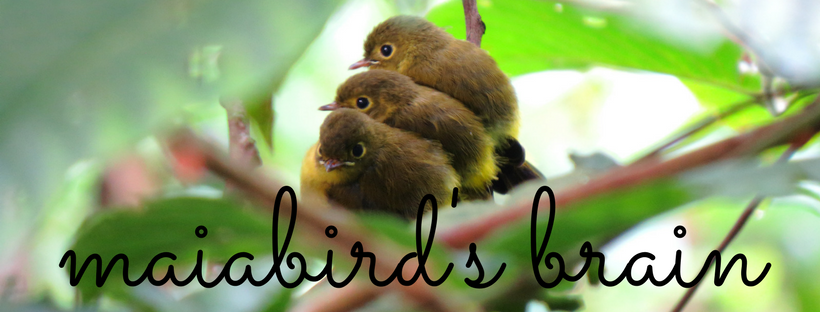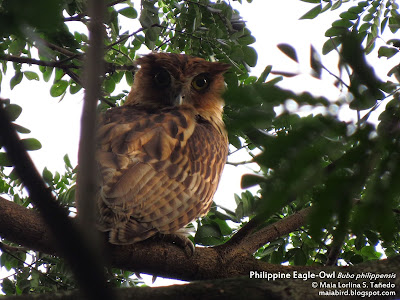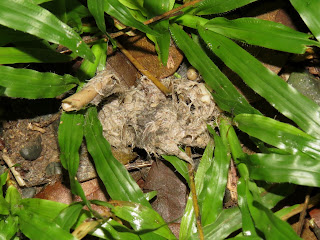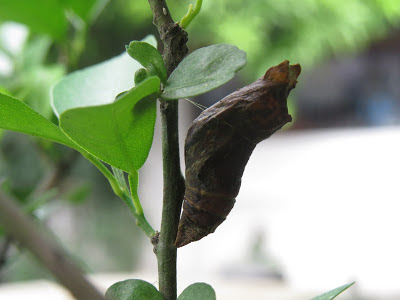 |
| Philippine Frogmouth sleeping soundly |
This second sighting was totally unexpected. The Wild Bird Club of the Philippines was invited by Timberland Heights to do a bird survey in their property in San Mateo, Rizal. Together with friends from the Philippine Native Plants Conservation Society, we were brought around the smaller subdivisions and other green areas of the huge property.
The heavy afternoon downpour had just slowed to a drizzle when we set out to bird. There wasn't much bird activity because of the rain save for White-breasted Wood-swallows, huddled together on branches and electric wires. In the second site, we were watching out for the occasional Yellow-vented Bulbul and fly-by Lowland White-eyes when Jason, Timberland's outdoor events coordinator, spotted a bird and pointed it out to Jops. "Frogmouth!" he exclaimed while already setting up the spotting scope. And there it was... sleeping soundly under a canopy of leaves, shielding it from the rain.
 |
| Everyone enjoyed the great views of the Philippine Frogmouth =) |
We left the Frogmouth to continue its sleep and proceeded to another area. The drizzle had stopped by the time we arrived in the next spot and we got to see some birds coming out to dry themselves. I was able to get some documentary shots of some of them. There was a Philippine Coucal crawling on a low branch before flying to the opposite side of the street, some Tawny Grassbirds calling semi-hidden in the grass, as well as some Long-tailed Shrikes who came out to perch on the wires above us.
 |
| Philippine Coucal |
 |
| Tawny Grassbird |
We visited a couple more sites and saw more or less the same species. That night, after a scrumptious dinner, we were all hoping to see some Grass Owls but the rain foiled any plans of us going owling. So, after a nightcap in our villa with friends old and new, we said our good nights and rested.
The following morning was rain-free and we were excited to go birding. We were brought to one of the bike trails where we immediately heard flowerpeckers calling hidden from the trees. Here we saw some Olive-backed Sunbirds, Elegant Tits, White-throated Kingfishers, lots of Lowland White-eyes, and a Black-naped Monarch.
 |
| A not-so-good- shot of an awesome Black-naped Monarch |
We walked through a cemented road which overlooked a ravine and some members spotted Scale-feathered Malkoha, Ashy Ground Thrush, and White-eared Brown Dove. There were also Pied Bushchats, Black-naped Orioles, Large-billed Crows, and Philippine Bulbuls.
 |
| Female Pied Bushchat |
 |
| One of the many Lowland White-eyes hungrily feeding on the fruit of an Anabiong tree |
We rounded the trail and were told we would head to another site. It was a short walk to the nursery area and we were able to see other wildlife around us. We saw a Green Crested Lizard, and thanks to a friend who identified it, said that it is also known as the chameleon of the Philippines because of its ability to change colors. Cool! It was my first time to see one!
 |
| Green Crested Lizard Bronchocela cristatella, a species indigenous to the Philippines |
We also saw some beautiful butterflies and dragonflies. Some of them stayed still long enough for us to photograph them.
 |
| A Lycaenid butterfly |
 |
| Possibly a male Crimson Marsh Glider Trithemis aurora |
The next leg of our hike was the longest and I was honestly not prepared for it. We started our trek past 10am and we found ourselves trying not to slip through a steep, slippery, muddy trail. Then it was a hot trek through open field with occasional inclines which is my major "enemy" when birding. Then, somewhere towards noon, the rain fell. The trail began to get very slippery and muddy again but we could see the cars waiting for us and we knew the long walk was over. Whew!
After a refreshing bath and hearty lunch, we drew up our bird list for the morning and came up with 41 species seen and heard. Not bad for two half days of birding and with patches of bad weather too. It was nice exploring the place and discovering different bird species as well as the large green spaces still left in the property.
 |
| We'll be back soon, Timberland =) |













